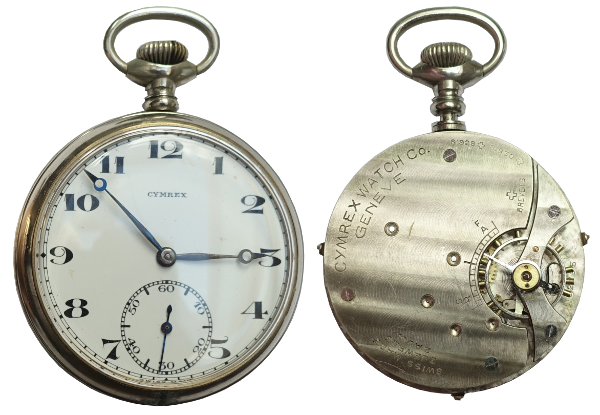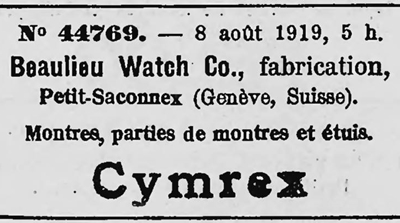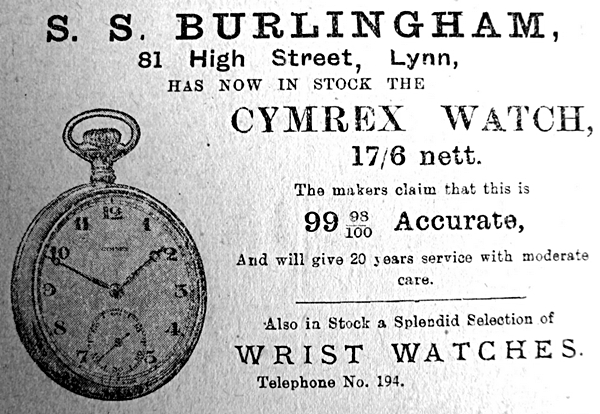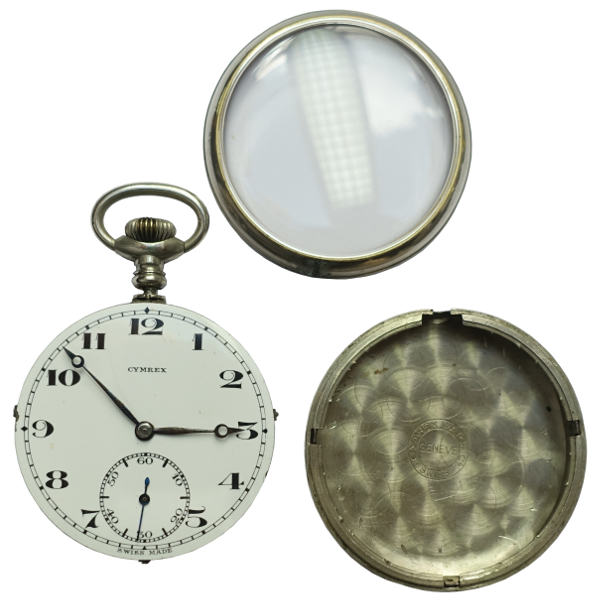
Let’s start with the manufacturer. CYMREX WATCH Co GENEVE is written on the movement and the CYMREX brand can also be found on the dial. This may mean that the watch and the movement come from the same source, but it doesn’t have to. So who was the Cymrex Watch Co?
As is so often the case, the Swiss Official Gazette of Commerce contains a notice on the registration of companies and trademarks:

Cymrex wurde also 1919 von der Beaulieu Watch Co. als Marke für Uhren registriert. Neben Cymrex hat die Beaulieu Watch auch die Marken Simrex, Cymric und Simplex registriert.
Cymrex was thus registered as a trademark for watches by the Beaulieu Watch Co. in 1919. In addition to Cymrex, Beaulieu Watch has also registered the trademarks Simrex, Cymric and Simplex.
Die Beaulieu Watch Co. wurde etwa ein Jahr zuvor, am 17.10.1918, als Firma in Le Petit-Saconnex gegründet. Le Petit-Saconnex war eine Gemeinde bei Genf, die 1930 in die Stadt Genf eingemeindet wurde.

A year after the registration of the Cymrex brand, the Cymrex Watch Co was finally founded in 1920. The Beaulieu Watch Co apparently continued to exist.

However, the company did not exist for long. As early as 03.05.1926, the company was officially dissolved, as it had ceased operations. The Cymrex brand was registered again by Record Watch in 1938, but this no longer has anything to do with the watches or movements presented here.
I could hardly find out anything about the business operations of Cymrex Watch. At least there are a few advertisements of Cymrex in different journals. One advertisement appeared in the British journal The Graphic on 16.04.1921. There the watch was advertised as accurate and cheap. The price was also given: 17s 6d, i.e. 17 shillings and 6 pence.

Also from 1921 is this advertisement by the British jeweller Burlingham:

The watch i advertised with an accuracy of 99.98 %. That sounds great, of course, but still describes a deviation of 17 seconds a day.
This advertisement appeared in The Bulletin in Sydney, Australia on 12.06.1924:

So Cymrex was probably quite active in the export business.
Let us now turn our attention to the factory and its patents.

When removing the movement from the case, some special features immediately catch the eye:

- The pendant with the bail to hold the watch chain is not part of the case, but integrated into the movement.
- The watch case consists of only two parts, a base part and the support ring for the glass.
- Accordingly, there are no movement retaining screws that could hold the movement from behind. Instead, there are three recesses in the base into which the corresponding protrusions on the movement are clamped. More about this in a moment.

- The dial is not screwed down, but held to the movement by clamps.

The movement shown above has a three-quarter plate. The same movement construction is also available with a detached barrel bridge, which makes changing the mainspring much easier. To distinguish between the two, I call the first variant type 1 and the second type 2.

Apart from this deviation, the technical data of the two Cymrex movement types are identical:
- Dimensions: 18 1/4´´´ (French Lignes) (41.2 mm), Height 5.5 mm
- Swiss lever escapement
- Hours, minutes, small second
- 7 juwels
- Monometallic screw balance
- Beate rate: 18,000 bph (beats per hour)
- No shock protection
- Rocking bar on the bridge side of the movement plate
Here are a few insights into the interior of the movement:

The ratchet wheel is mounted on the underside of the barrel:

The corresponding click is located on the movement plate (SK):

The green line shows the power flow of the gear train from the barrel to the escape wheel. The blue line shows the power flow when the hands are set with the crown pulled out. By the way, the movement does not have a classic cannon pinion; instead, the friction of the hands takes place directly on the pinion of the minute wheel.
On the type 1 movement shown first, there are two patent numbers on the three-quarter plate, 81928 and 81930. The Swiss patent CH81928 of 1919 bears the simple title Montre (Watch):

It merely describes the idea of anchoring the pendant in the movement rather than on the case.
Patent CH81930 of 1919 is also entitled Montre (Watch) and describes a mounting of the movement in the case back similar to the one shown above, but with the protuberances on the movement facing inwards:

But that’s not all, the Cymrex Watch received a total of 13 patents in Switzerland, France, Great Britain and Germany! CH81932, for example, describes the fastening of the dial with clamps shown above. And CH81934 describes the winding mechanism of the Cymrex movements:

In 1923, some patents from 1921 were transferred to the Beaulieu Watch Co by a Georges Henry: CH95252, CH98593, CH98831, CH98832. This Georges Henry had already been appointed director of Beaulieu Watch in 1919. The patents he filed were therefore already created during his time at Beaulieu Watch.
CH98593 von 1921 handelt von einem transparenten Staubdeckel. Die Zeichnung zu diesem Patent zeigt exakt die Brückenform der Cymrex-Werke:
CH98593 from 1921 is about a transparent dust cover. The drawing for this patent shows exactly the bridge shape of the Cymrex movements:

We can therefore assume that the Cymrex movements shown were built between 1919 and 1926. A number is stamped on the plate under the balance wheel, which may be a consecutive serial number. The highest number I could find so far was 144090, so the total number of movements produced by Cymrex could be around 150,000. I suspect that type 1 movements are older than type 2 movements because type 2 movements have higher numbers.

Hello I have a model with serial 79306 it’s a type 2. The dial has the watch dealers name in 3 lines as follows
W.A.PERRY & Co
“CYMREX”
BIRMINGHAM
it’s ticking away and keeping pretty good time . I have taken a few photos and a video of the movement running which I can share etc
Kind regards
Adrian ( from Brighton UK )
Thank you, I bought one of these as a non runner from Ebay and have stripped it down to repair. This is my first watch and I had left it too long before starting to rebuild it, the diagrams of the movement have proved really useful and I’ll reference these. I have saved you to my bookmarks and will revisit the site as I learn more on watch repairs.
Thanks again
Regards
Andy